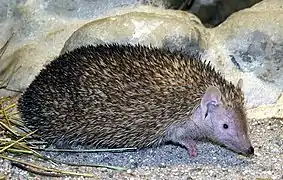Tenrecinae
Tenrecinae is a tenrec subfamily endemic to the island of Madagascar.[1] It contains the largest species in the family, Tenrec ecaudatus.[2] All members of the genus possess spines, analogous to those of hedgehogs, for defense against predators.
| Tenrecinae | |
|---|---|
 | |
| Lesser hedgehog tenrec (Echinops telfairi) | |
| Scientific classification | |
| Kingdom: | Animalia |
| Phylum: | Chordata |
| Class: | Mammalia |
| Order: | Afrosoricida |
| Suborder: | Tenrecomorpha |
| Family: | Tenrecidae |
| Subfamily: | Tenrecinae Gray, 1821 |
| Genera | |
| |
Tenrecinae is thought to have split from the lineages of all other extant tenrecs about 36 million years (Ma) ago. The deepest phylogenetic split within the subfamily, that between two clades composed of Echinops plus Setifer and Hemicentetes plus Tenrec, is thought to have occurred about 26 Ma ago. In turn, Hemicentetes is thought to have diverged from Tenrec about 16 Ma ago, and Echinops from Setifer about 10 Ma ago.[3]
Extant species
Subfamily Tenrecinae
- Genus Echinops
- Lesser hedgehog tenrec (E. telfairi)
- Genus Hemicentetes
- Highland streaked tenrec (H. nigriceps)
- Lowland streaked tenrec (H. semispinosus)
- Genus Setifer
- Greater hedgehog tenrec (S. setosus)
- Genus Tenrec
- Tailless tenrec (T. ecaudatus)
References
- Bronner, G.N.; Jenkins, P.D. (2005). "Order Afrosoricida". In Wilson, D.E.; Reeder, D.M (eds.). Mammal Species of the World: A Taxonomic and Geographic Reference (3rd ed.). Johns Hopkins University Press. pp. 76–77. ISBN 978-0-8018-8221-0. OCLC 62265494.
- Stephenson, P.J.; Soarimalala, V.; Goodman, S. (2016). "Tenrec ecaudatus". IUCN Red List of Threatened Species. IUCN. 2016: e.T40595A97204107. doi:10.2305/IUCN.UK.2016-1.RLTS.T40595A97204107.en. Retrieved 2 February 2019.CS1 maint: uses authors parameter (link)
- Everson, K. M.; Soarimalala, V.; Goodman, S. M.; Olson, L. E. (2016). "Multiple Loci and Complete Taxonomic Sampling Resolve the Phylogeny and Biogeographic History of Tenrecs (Mammalia: Tenrecidae) and Reveal Higher Speciation Rates in Madagascar's Humid Forests". Systematic Biology. 65 (5): 890–909. doi:10.1093/sysbio/syw034. PMID 27103169.
This article is issued from Wikipedia. The text is licensed under Creative Commons - Attribution - Sharealike. Additional terms may apply for the media files.